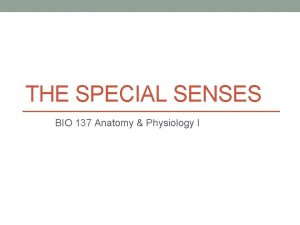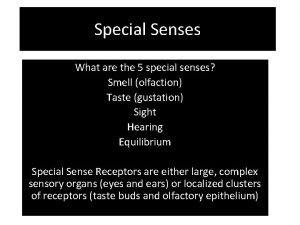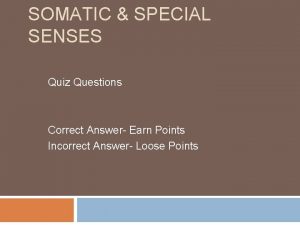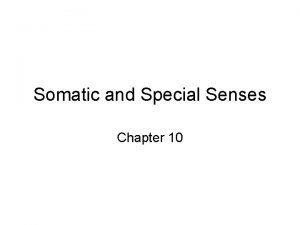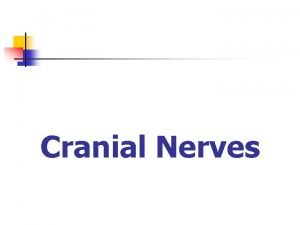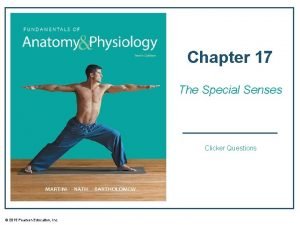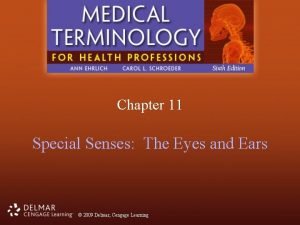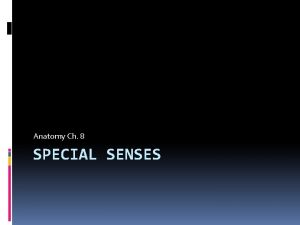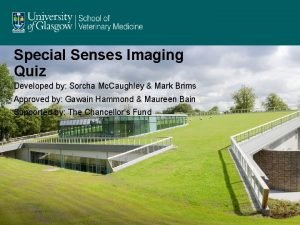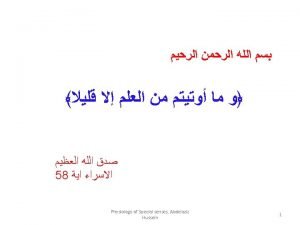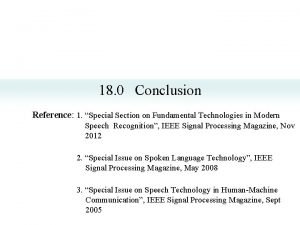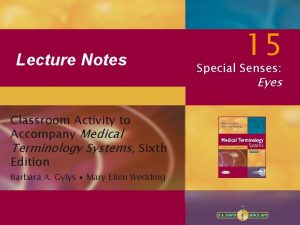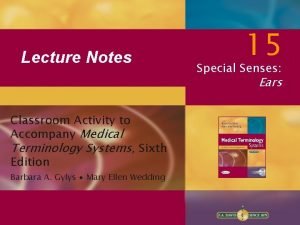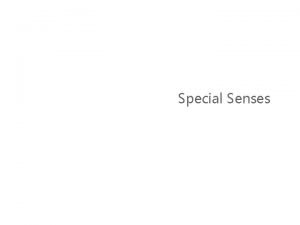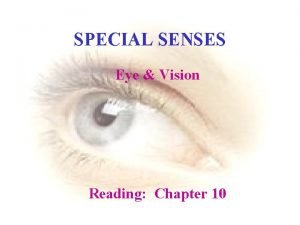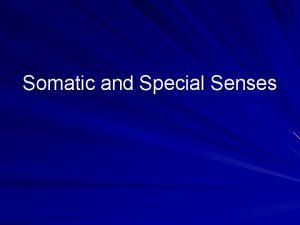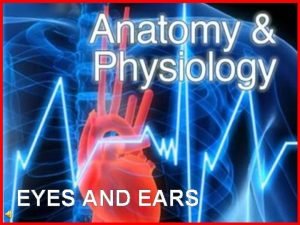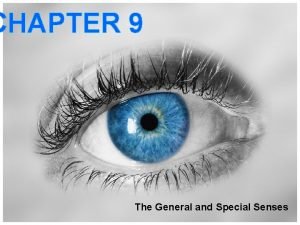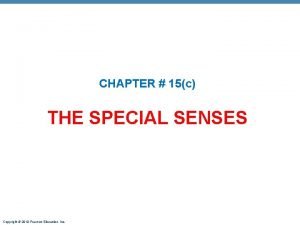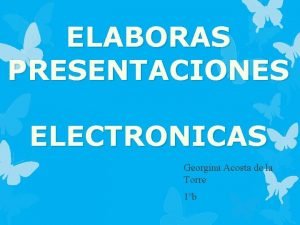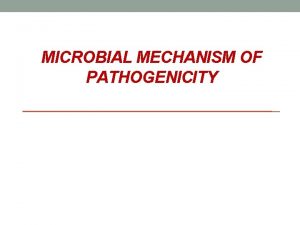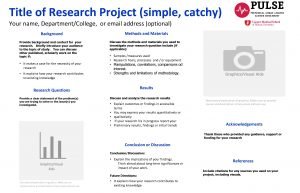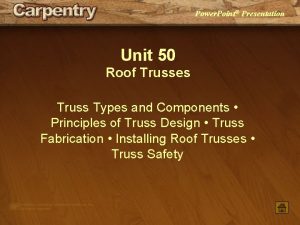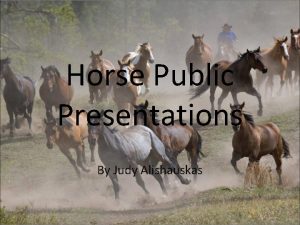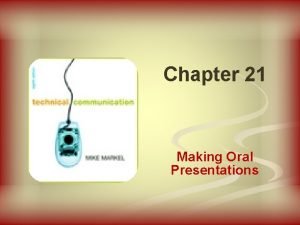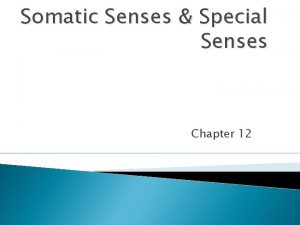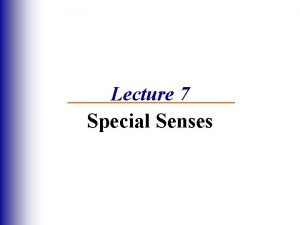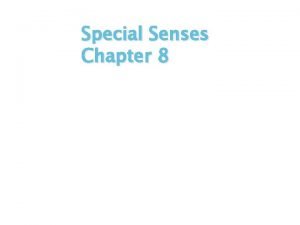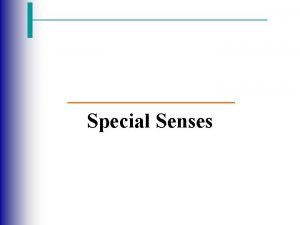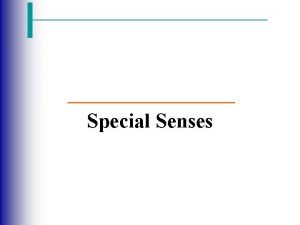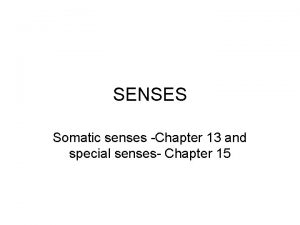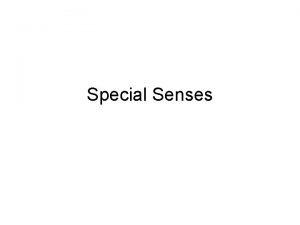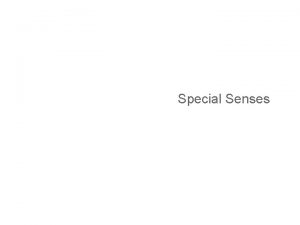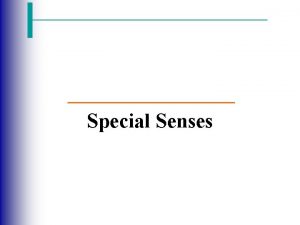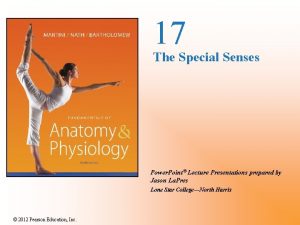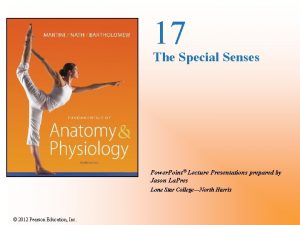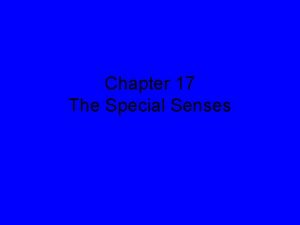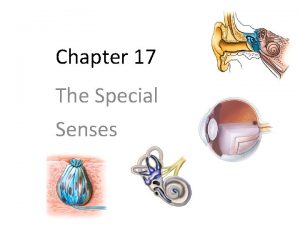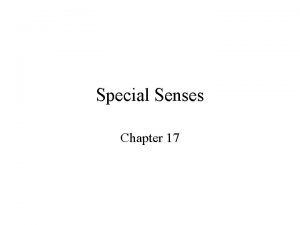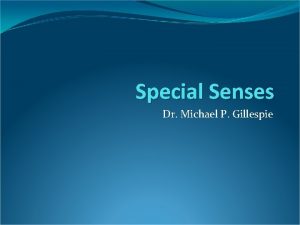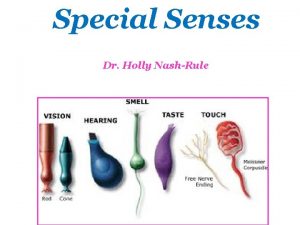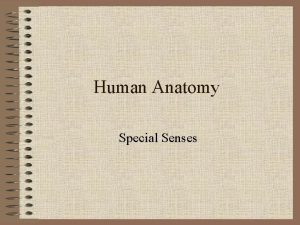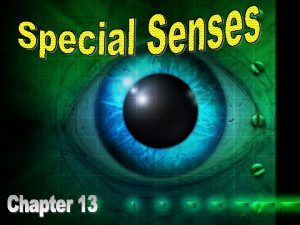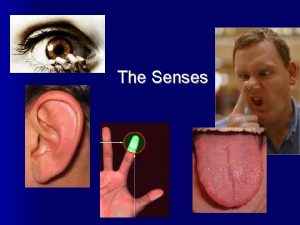16 The Special Senses Power Point Lecture Presentations













































































- Slides: 77

16 The Special Senses Power. Point® Lecture Presentations prepared by Leslie Hendon University of Alabama, Birmingham © 2014 Pearson Education, Inc.

I. The Special Senses A. Include: taste, smell, sight, hearing, and balance B. Special sensory receptors 1. localized - confined to the head region 2. receptors are distinct specialized receptor cells 3. are neuron-like epithelial cells or small peripheral neurons 4. transfer sensory info to other neurons via afferent pathways © 2014 Pearson Education, Inc.

II. Taste and Smell A. Taste (gustation) and Smell – (olfaction) B. Receptors are classified as chemoreceptors 1. respond to specific chemicals (shape of molecules) a. food dissolved in saliva b. airborne chemicals that dissolve in fluids of nasal mucosa C. Taste receptors - occur in taste buds 1. most are found on the surface of the tongue 2. located within tongue papillae (e. g. fungiform, villate, etc. ) © 2014 Pearson Education, Inc.

D. Taste Buds - collection of 50– 100 epithelial cells 1. contain two major cell types a. gustatory epithelial cells: supporting cells b. basal epithelial cells: gustatory cells 2. contain long microvilli - extend through a taste pore to surface 3. cells in taste buds replaced every 7– 10 days E. Taste information reaches the cerebral cortex: 1. primarily through the facial (VII) and glossopharyngeal (IX) 2. some taste information through the vagus nerve (X) © 2014 Pearson Education, Inc.

Taste fibers of cranial nerve Foliate papillae Vallate papilla Fungiform papillae © 2014 Pearson Education, Inc. Taste bud

Three Cranial Nerves carry taste information Facial nerve (VII) Glossopharyngeal nerve (IX) © 2014 Pearson Education, Inc. Vagus nerve (X)

F. Olfactory receptors - part of the olfactory epithelium 1. olfactory epithelium is pseudostratified columnar a. olfactory sensory neurons b. located in olfactory epithelium c. ends in a knob from which olfactory cilia radiate d. olfactory cilia act as receptive structures for smell e. mucus captures and dissolves odor molecules © 2014 Pearson Education, Inc.

Olfactory epithelium Olfactory tract (I) Olfactory bulb Olfactory tract Cribriform plate of ethmoid bone Olfactory bulb Filaments of olfactory nerve Olfactory axon Olfactory epithelium Mucus © 2014 Pearson Education, Inc. Olfactory sensory neuron Olfactory cilia

G. Disorders of Chemical Senses 1. anosmia - absence of the sense of smell a. due to injury, colds, allergies, or zinc deficiency 2. uncinate fits - distortion of smells or olfactory hallucinations a. often result from irritation of olfactory pathways b. typically after brain surgery or head trauma © 2014 Pearson Education, Inc.

III. The Eye and Vision A. Vision - the dominant sense in humans 1. 70% of all sensory receptors are in the eyes 2. 40% of cortex involved in processing visual information 3. anterior one-sixth of the eye’s surface is visible © 2014 Pearson Education, Inc.

B. Accessory structures of the eye 1. eyebrows - coarse hairs on the superciliary arches 2. eyelids (palpebrae) - separated by the palpebral fissure 3. lacrimal caruncle - reddish elevation at the medial canthus 4. tarsal plates - connective tissue within the eyelids 5. tarsal glands - modified sebaceous glands © 2014 Pearson Education, Inc.

III. The Eye and Vision B. Accessory structures of the eye (cont’d) 6. conjunctiva - transparent mucous membrane 7. lacrimal apparatus - (tears) keeps the surface of the eye moist a. lacrimal gland - produces lacrimal fluid b. lacrimal sac - fluid empties into nasal cavity © 2014 Pearson Education, Inc.

Eyebrow Tarsal plate Tarsal glands Palpebral fissure Eyelashes Conjunctival sac © 2014 Pearson Education, Inc. Lateral view; some structures shown in sagittal section

© 2014 Pearson Education, Inc. Lateral view; some structures shown in sagittal section

Lacrimal sac Lacrimal gland Excretory ducts of lacrimal glands Lacrimal punctum Nasolacrimal duct © 2014 Pearson Education, Inc.

© 2014 Pearson Education, Inc.

Extrinsic eye muscles Muscle Action Controlling cranial nerve Lateral rectus Moves eye laterally VI (abducens) Medial rectus Moves eye medially III (oculomotor) Superior rectus Elevates eye and turns it medially III (oculomotor) Inferior rectus Depresses eye and turns it medially III (oculomotor) Inferior oblique Elevates eye and turns it laterally III (oculomotor) Superior oblique Depresses eye and turns it laterally IV (trochlear) © 2014 Pearson Education, Inc.

Superior oblique muscle Superior rectus muscle Lateral rectus muscle Inferior rectus muscle Lateral view of the right eye © 2014 Pearson Education, Inc. Inferior oblique muscle

IV. Anatomy of the Eyeball A. Components of the eye 1. protect and support the photoreceptors (rods and cones) 2. gather, focus, and process light into precise images a. anterior pole - most anterior part of the eye b. posterior pole - most posterior part of the eye c. external walls - composed of three tunics d. internal cavity - contains fluids (humors) © 2014 Pearson Education, Inc.

WOW!!! Be patient!!! Ciliary body Suspensory ligament Cornea Iris Sclera Choroid Retina Fovea centralis Pupil Optic nerve Anterior segment (contains aqueous humor) Lens Central artery and vein of the retina Posterior segment (contains vitreous humor) © 2014 Pearson Education, Inc. Optic disc (blind spot)

B. Most external layer (tunic) of the eyeball 1. composed of two regions of connective tissue a. sclera - posterior five-sixths of the tunic ► “white” and opaque region ► provides shape and an anchor for eye muscles b. cornea—anterior one-sixth of the fibrous tunic ► contact lens rests on this surface © 2014 Pearson Education, Inc.

Sclera Cornea Optic nerve Lens © 2014 Pearson Education, Inc.

© 2014 Pearson Education, Inc.

C. The Vascular Layer (Tunic) – middle part of the eyeball 1. Choroid - vascular, darkly pigmented membrane a. forms posterior five-sixths of the vascular tunic b. brown color - from melanocytes 2. Ciliary body – thick ring of tissue, which encircles the lens a. composed of ciliary muscle b. suspensory ligament - circumference of the lens 3. Iris - visible colored part of the eye (brown, blue, green) a. attached to the ciliary body b. composed of smooth muscle c. Pupil—the round, central opening © 2014 Pearson Education, Inc.

Ciliary body Suspensory ligament Sclera Choroid Cornea Iris Pupil Optic nerve Lens © 2014 Pearson Education, Inc.

© 2014 Pearson Education, Inc.

Pupil dilation and constriction Sympathetic Parasympathetic Sphincter pupillae muscle contracts: Pupil size decreases. © 2014 Pearson Education, Inc. Iris (two muscles) • Sphincter pupillae • Dilator pupillae muscle contracts: Pupil size increases.

C. Retina (the Inner Layer) – light detecting layer of the eyeball 1. Composed of two layers a. pigmented layer - single layer of melanocytes b. neural layer - sheet of nervous tissue with 3 cell types path photoreceptors ► bipolar cells ► ganglion cells (form optic nerve II) 2. Photoreceptors – detect light and translate into nerve impulses a. rods – used in low light levels; do not detect color b. cones – used in normal light; can detect colors © 2014 Pearson Education, Inc.

Neural layer of retina Pigmented layer of retina Pathway of light Choroid Sclera Optic disc Optic nerve © 2014 Pearson Education, Inc.

Ganglion cells Axons of ganglion cells Bipolar cells Photoreceptors Rod Cone Microscopic anatomy of the retina Pathway of signal output Pathway of light Pigmented layer of retina Cells of the neural layer of the retina © 2014 Pearson Education, Inc.

Choroid Microscopic anatomy of the retina Axons of ganglion cells Nuclei of bipolar cells Nuclei of rods and cones Photomicrograph of retina © 2014 Pearson Education, Inc. Pigmented layer of retina

t Ligh t Lig ht Process of bipolar cell Synaptic terminals Inner fibers Rod cell body Nuclei Cone cell body Mitochondria Outer fiber Photoreceptors – Rods and Cones Outer segment Pigmented layer Inner segment Connecting cilia Apical microvillus Discs containing visual pigments Discs being phagocytized Melanin granules Pigment cell nucleus Basal lamina (border with choroid) © 2014 Pearson Education, Inc.

Ciliary body Suspensory ligament Sclera Choroid Retina Cornea Iris Pupil Optic nerve Lens © 2014 Pearson Education, Inc.

© 2014 Pearson Education, Inc.

C. Retina (cont’d) 3. Other structures a. fovea centralis - only cones; region of highest acuity b. optic disc - blind spot = no photoreceptors in this area c. central artery and vein © 2014 Pearson Education, Inc.

Ciliary body Suspensory ligament Cornea Iris Sclera Choroid Retina Fovea centralis Pupil Optic nerve Lens Central artery and vein of the retina Optic disc (blind spot) © 2014 Pearson Education, Inc.

© 2014 Pearson Education, Inc.

Posterior wall of the right eye as seen with an ophthalmoscope Central artery and vein Optic disc Retina © 2014 Pearson Education, Inc.

V. Internal Chambers and Fluids A. The lens and ciliary zones divide the eye into two segments B. Posterior segment (cavity) 1. filled with vitreous humor - a clear, jellylike substance a. transmits light b. supports the posterior surface of the lens c. helps maintain intraocular pressure © 2014 Pearson Education, Inc.

C. Anterior segment (cavity) 1. filled with aqueous humor - a clear, jellylike substance a. Anterior chamber - between the cornea and iris b. Posterior chamber - between the iris and lens © 2014 Pearson Education, Inc.

Cornea Iris Lens Cornea 2 Posterior segment Aqueous humor Anterior segment Vitreous humor Anterior chamber Posterior chamber 3 1 Ciliary processes Ciliary muscle Sclera © 2014 Pearson Education, Inc. Ciliary body

Ciliary body Suspensory ligament Cornea Iris Sclera Choroid Retina Fovea centralis Pupil Posterior pole Anterior pole Optic nerve Anterior segment (contains aqueous humor) Lens Central artery and vein of the retina Posterior segment (contains vitreous humor) © 2014 Pearson Education, Inc. Optic disc (blind spot)

The Parts of the Eyeball © 2014 Pearson Education, Inc.

IV. Visual Pathways A. Most visual information travels to the cerebral cortex 1. Occipital lobe (1◦ visual cortex) - responsible for “seeing” B. Pathway begins at the retina ► light activates photoreceptors ► photoreceptors signal bipolar cells ► bipolar cells signal ganglion cells ► axons of ganglion cells exit eye as the optic nerve © 2014 Pearson Education, Inc.

C. The path of visual information 1. axons of ganglion cells of retina form the optic nerves to 2. optic chiasma (fibers from medial aspect of retina cross over) to 3. lateral geniculate nucleus of the thalamus to 4. optic radiations to 5. primary visual cortex (occipital lobe) NOTE: axons from medial aspect of each retina cross to opposite side axons from lateral aspect of each retinal stay on the same side © 2014 Pearson Education, Inc.

Both eyes Righ ly e on t ey e on Lef ly Fixation point Right eye Left eye Optic nerve Optic chiasma Optic tract Lateral geniculate nucleus of thalamus Crossed (contralateral) fiber Optic radiation Occipital lobe (primary visual cortex) © 2014 Pearson Education, Inc.

V. The Ear: Hearing and Equilibrium A. Ear - receptor organ for hearing and equilibrium B. Composed of three main regions 1. outer ear - functions in hearing 2. middle ear - functions in hearing 3. internal ear - functions in both hearing and equilibrium © 2014 Pearson Education, Inc.

C. Outer Ear 1. auricle (pinna) - helps direct sounds 2. external acoustic meatus a. hairs, sebaceous glands, and ceruminous glands 3. tympanic membrane (“ear drum”) a. boundary between the external and middle ear © 2014 Pearson Education, Inc.

External ear Middle ear Internal ear (labyrinth) Auricle (pinna) Helix Lobule External acoustic meatus The three regions of the ear © 2014 Pearson Education, Inc. Tympanic membrane Pharyngotympanic (auditory) tube

D. Middle Ear 1. tympanic cavity - small, air-filled space in temporal bone 2. medial wall is penetrated by a. oval window b. round window 3. pharyngotympanic tube (auditory tube) - links to pharynx 4. ear ossicles - smallest bones in the body a. malleus - attaches to the eardrum b. incus - between the malleus and stapes c. stapes - vibrates against the oval window 5. tensor tympani and stapedius a. two tiny skeletal muscles in the middle ear cavity © 2014 Pearson Education, Inc.

Oval window (deep to stapes) Semicircular canals Vestibule Malleus (hammer) Auditory ossicles Incus (anvil) Stapes (stirrup) Tympanic membrane Round window Middle and internal ear © 2014 Pearson Education, Inc. Vestibular nerve Cochlea Pharyngotympanic (auditory) tube

View Superior Malleus Incus Lateral Anterior Pharyngotympanic tube © 2014 Pearson Education, Inc. Tensor tympani muscle Stapes Tympanic membrane (medial view) Stapedius muscle

E. Inner Ear 1. is also called the labyrinth 2. lies within the petrous part of the temporal bone 3. consisting of three parts a. semicircular canals b. vestibule c. cochlea © 2014 Pearson Education, Inc.

Oval window (deep to stapes) Entrance to mastoid antrum in the epitympanic recess Semicircular canals Vestibule Malleus (hammer) Auditory ossicles Incus (anvil) Stapes (stirrup) Tympanic membrane Round window Middle and internal ear © 2014 Pearson Education, Inc. Vestibular nerve Cochlea Pharyngotympanic (auditory) tube

Middle and internal ear © 2014 Pearson Education, Inc.

E. Inner Ear (cont’d) 4. membranous labyrinth a. filled with fluid called endolymph b. fits within the bony labyrinth (filled with parilymph) c. contains three membrane-walled sacs and ducts i. semicircular canals ii. utricle and saccule iii. cochlear duct © 2014 Pearson Education, Inc.

Semicircular canals Vestibular nerve Cochlear nerve Utricle in vestibule Saccule in vestibule © 2014 Pearson Education, Inc. Cochlea

© 2014 Pearson Education, Inc.

VI. The Cochlea A. A spiraling structure in the bony labyrinth B. Coils around a pillar of bone C. Has three different chambers 1. cochlear duct (scala media) - contains receptors for hearing a. vestibular membrane - the roof of the cochlear duct b. basilar membrane - the floor of the cochlear duct 2. scala vestibuli 3. scala tympani © 2014 Pearson Education, Inc.

The COCHLEA cut into a wedge. Cochlear nerve Scala tympani Cochlear duct Scala vestibuli © 2014 Pearson Education, Inc.

Cross-section through COCHLEA showing chambers and membranes Vestibular membrane Tectorial membrane Scala vestibuli Spiral organ (Organ of Corti) Cochlear duct Basilar membrane © 2014 Pearson Education, Inc. Scala tympani

D. Spiral organ (Organ of Corti) – contain receptors for hearing 1. hair cells (receptor cells for hearing) a. sit on the basilar membrane b. tectorial membrane sits on the stereocilia of the hair cells © 2014 Pearson Education, Inc.

Microscopic view of the Spiral Organ (Organ of Corti) Tectorial membrane Hairs (stereocilia) Hair cells Fibers of cochlear nerve Basilar membrane © 2014 Pearson Education, Inc.

1 – (1000 X) The COCHLEA cut into a wedge. Cochlear nerve Scala tympani Cochlear duct Scala vestibuli © 2014 Pearson Education, Inc.

2 – (5000 X) Cross-section through COCHLEA showing chambers and membranes Vestibular membrane Tectorial membrane Scala vestibuli Spiral organ (Organ of Corti) Cochlear duct Basilar membrane © 2014 Pearson Education, Inc. Scala tympani

3 – (10, 000 X) Microscopic view of the Spiral Organ (Organ of Corti) Tectorial membrane Hairs (stereocilia) Hair cells Fibers of cochlear nerve Basilar membrane © 2014 Pearson Education, Inc.

Helicotrema at apex Modiolus Cochlear nerve, division of the vestibulocochlear nerve (VIII) Spiral ganglion Osseous spiral lamina Vestibular membrane Cochlear duct (scala media) Vestibular membrane Tectorial membrane Cochlear duct (scala media; contains endolymph) Osseous spiral lamina Scala vestibuli (contains perilymph) Basilar membrane Inner hair cell Hairs (stereocilia) Afferent nerve fibers Outer hair cells Supporting cells Stria vascularis Spiral organ Spiral ganglion Tectorial membrane Fibers of cochlear nerve Scala tympani (contains perilymph) Basilar membrane Inner hair cell Outer hair cell © 2014 Pearson Education, Inc.

VII. The Vestibule A. The organ for detecting linear movement and balance B. Lies medial to the middle ear C. Composed of two organs: 1. utricle – horizontal accelleration 2. saccule – vertical accelleration D. Macula – contains receptor cells called hair cells 1. synapse with the vestibular nerve 2. tips of hair cells are embedded in otolith membrane 3. contains crystals of calcium carbonate called otoliths © 2014 Pearson Education, Inc.

Temporal bone Maculae Utricle in vestibule Saccule in vestibule © 2014 Pearson Education, Inc.

Macula of utricle Otoliths Stereocilia Macula of saccule Otolith membrane Macula Hair cells Vestibular nerve fibers © 2014 Pearson Education, Inc.

Otolith membrane Otoliths Head upright © 2014 Pearson Education, Inc. Hair cell Force of gravity Head tilted

VII. The Semicircular Canals A. Lie posterior and lateral to the vestibule at right angles B. One canal lies in each of the three dimensional planes (X, Y, Z) 1. anterior semicircular canal 2. posterior semicircular canal 3. lateral semicircular canal C. Semicircular duct – space within each canal D. Membranous ampulla – has a structure called a crista ampullaris 1. cristae contain receptor cells of angular acceleration 2. epithelium contains receptor hair cells © 2014 Pearson Education, Inc.

Semicircular canals with cristae ampularis Temporal bone Semicircular ducts in semicircular canals Anterior Posterior Lateral Cristae ampullares in the membranous ampullae © 2014 Pearson Education, Inc.

Cristae ampularis Ampullary cupula Crista ampullaris Endolymph Hair bundle (kinocilium plus stereocilia) Membranous labyrinth Crista ampullaris Fibers of vestibular nerve Anatomy of a crista ampullaris in a semicircular canal © 2014 Pearson Education, Inc. Hair cell Supporting cell

Section of ampulla, filled with endolymph Ampullary cupula Fibers of vestibular nerve At rest, the ampullary cupula stands upright. Flow of endolymph During rotational acceleration, endolymph moves inside the semicircular canals in the direction opposite the rotation (it lags behind because of inertia). Endolymph flow bends the ampullary cupula and excites the hair cells. Movement of the ampullary cupula during rotational acceleration and deceleration © 2014 Pearson Education, Inc. As rotational movement slows, endolymph keeps moving in the direction of the rotation, bending the ampullary cupula in the opposite direction from acceleration and inhibiting the hair cells.

VIII. Auditory Pathway A. The ascending auditory pathway ► cochlear nerve ► spiral ganglion of cochlear nerve ► cochlear nuclei ► medulla ► inferior colliculus ► medical geniculate nucleus of the thalamus ► primary auditory cortex (temporal lobe) © 2014 Pearson Education, Inc.

Medial geniculate nucleus of thalamus Primary auditory cortex in temporal lobe Inferior colliculus Lateral lemniscus Superior olivary nucleus (ponsmedulla junction) Midbrain Cochlear nuclei Vibrations Medulla Vestibulocochlear nerve Vibrations Spiral ganglion of cochlear nerve Bipolar cell Spiral organ © 2014 Pearson Education, Inc.
 What is the difference between somatic and special senses
What is the difference between somatic and special senses Special vs general senses
Special vs general senses Slidetodoc.com
Slidetodoc.com Bio 137
Bio 137 5 special senses
5 special senses Special senses physiology
Special senses physiology Chapter 10 somatic and special senses
Chapter 10 somatic and special senses Cranial nerve acronym
Cranial nerve acronym Chapter 17 special senses answer key
Chapter 17 special senses answer key Medical terminology chapter 11 learning exercises answers
Medical terminology chapter 11 learning exercises answers Anatomy and physiology chapter 8 special senses
Anatomy and physiology chapter 8 special senses Eye anatomy
Eye anatomy Special senses quiz
Special senses quiz Special senses
Special senses Conclusion of special senses
Conclusion of special senses Building vocabulary activity: the special senses
Building vocabulary activity: the special senses Building vocabulary activity: the special senses
Building vocabulary activity: the special senses Houses the receptors for hearing
Houses the receptors for hearing Emmentropia
Emmentropia General and special senses
General and special senses Somatic senses
Somatic senses Special senses the eyes and ears
Special senses the eyes and ears The general and special senses chapter 9
The general and special senses chapter 9 Pearson
Pearson Chapter 15 special senses
Chapter 15 special senses 01:640:244 lecture notes - lecture 15: plat, idah, farad
01:640:244 lecture notes - lecture 15: plat, idah, farad Real power and reactive power
Real power and reactive power Power bi training powerpoint
Power bi training powerpoint Point point power
Point point power Power system dynamics and stability lecture notes
Power system dynamics and stability lecture notes Power system analysis lecture notes
Power system analysis lecture notes Power semiconductor devices lecture notes
Power semiconductor devices lecture notes Switch mode power supply lecture notes
Switch mode power supply lecture notes Power system dynamics and stability lecture notes
Power system dynamics and stability lecture notes Things fall apart traditions and customs
Things fall apart traditions and customs The craft of scientific presentations
The craft of scientific presentations Titles for mental health presentations
Titles for mental health presentations Best and worst powerpoint presentations
Best and worst powerpoint presentations To maintain audience interest in a multimedia presentation
To maintain audience interest in a multimedia presentation Corel presentations ventajas y desventajas
Corel presentations ventajas y desventajas Designing and delivering oral and online presentation
Designing and delivering oral and online presentation Verbal support
Verbal support Tok presentations
Tok presentations World's worst presentation
World's worst presentation Anna ritchie allan
Anna ritchie allan Setting up ria
Setting up ria Boardworks presentations
Boardworks presentations Scqa structure
Scqa structure Internet presentations
Internet presentations Who is lazarus in the most dangerous game
Who is lazarus in the most dangerous game Cue cards for speech
Cue cards for speech The end pictures for presentations
The end pictures for presentations Useful phrases for presentations
Useful phrases for presentations Efficient elements powerpoint
Efficient elements powerpoint You exec presentations
You exec presentations Research project title
Research project title Research project name
Research project name First aid merit badge powerpoint
First aid merit badge powerpoint Customer service presentations
Customer service presentations Aironet 3500 presentations
Aironet 3500 presentations Bad powerpoint presentations examples
Bad powerpoint presentations examples Really bad powerpoint
Really bad powerpoint Youexec
Youexec Roof ppt presentations
Roof ppt presentations Www.yoursite.com
Www.yoursite.com Horse topics for presentations
Horse topics for presentations Types of oral presentations
Types of oral presentations Hình ảnh bộ gõ cơ thể búng tay
Hình ảnh bộ gõ cơ thể búng tay Lp html
Lp html Bổ thể
Bổ thể Tỉ lệ cơ thể trẻ em
Tỉ lệ cơ thể trẻ em Gấu đi như thế nào
Gấu đi như thế nào Chụp phim tư thế worms-breton
Chụp phim tư thế worms-breton Hát lên người ơi
Hát lên người ơi Môn thể thao bắt đầu bằng từ chạy
Môn thể thao bắt đầu bằng từ chạy Thế nào là hệ số cao nhất
Thế nào là hệ số cao nhất Các châu lục và đại dương trên thế giới
Các châu lục và đại dương trên thế giới Công của trọng lực
Công của trọng lực



